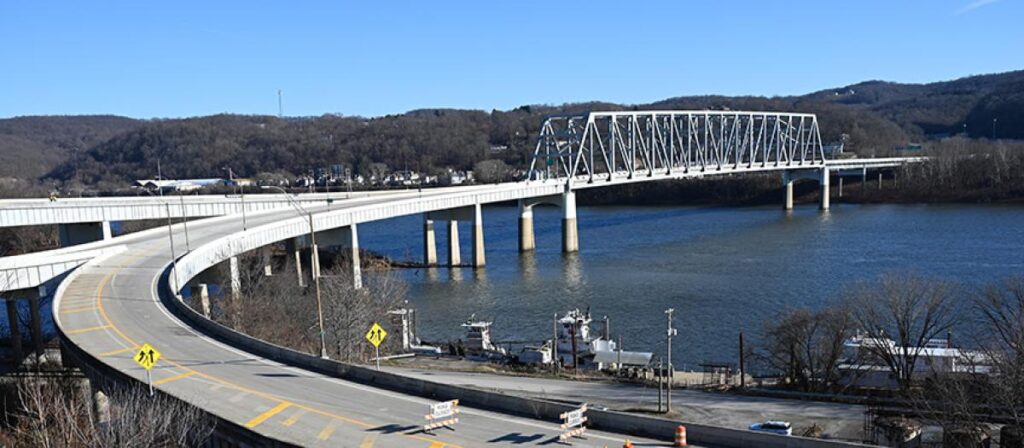Tue January 02, 2024 – Northeast Edition
Photo courtesy of the West Virginia Department of Transportation
The bridge, which carries U.S. Highway 33 across the Ohio River between the town of Chester and East Liverpool, Ohio, was closed Dec. 11 after a federally mandated inspection discovered cracking in two welds on the steel structure.
Modjeski & Masters, one of the world’s leading bridge engineering firms, is designing plans for permanent repairs to the Jennings Randolph Bridge in Chester, W. Va., as the state’s Division of Highways (WVDOH) prepares to reopen the span.
Based in Mechanicsburg, Pa., the noted contractor maintains an office in Charleston, W. Va.
The bridge, which carries U.S. Highway 33 across the Ohio River between the town of Chester and East Liverpool, Ohio, was closed Dec. 11 after a federally mandated inspection discovered cracking in two welds on the steel structure. The cracks were not visible to the naked eye, but WVDOH, in an abundance of caution, decided to close the bridge to devise a repair plan.
The cracks were arrested using dogbone repairs performed by WVDOH bridge crews from its Central Forces, or CenForce, a group of workers with unique skills who can be sent around the state to tackle projects requiring special expertise.
In a dogbone repair, two holes are drilled parallel to one another below and above the crack, then the holes are connected with a horizontal cut through the steel to stop the crack from getting any bigger.
At the same time, Modjeski & Masters conducted additional inspections on the bridge to look for additional defects, while WVDOH bridge engineers continued evaluating the structure and planning for future repairs.
CenForce personnel cut access holes into the steel bridge beams to allow contractors inside to inspect the welds from the inside out. Since the cracks were discovered, WVDOH bridge engineers have been in constant communication with inspectors and contractors to determine the best and fastest way to repair the bridge and reopen it to traffic.
Cracks Developed in T-1 Steel Welds
The Jennings Randolph Bridge was built in 1977 using T-1 steel. At the time, welded T-1 steel was common in bridge construction, but it was later discovered that cracks could develop in the welds joining the beams. Cracks in T-1 steel welds also led to the 2011 closure of the Interstate 64 Sherman Minton Bridge across the Ohio River in Louisville, Ky., and the I-40 Hernando de Soto Bridge over the Mississippi in Memphis, Tenn. in 2021.
Welding codes were amended in the 1990s, and all T-1 steel was required to pass inspection before factory shipping.
More recently, the federal government required specialized testing on all bridges made with T-1 steel. Special testing on bridges made with T-1 steel has since been conducted on bridges all across the United States.
It was during one of those tests that a few cracks were identified in welds on the Jennings Randolph Bridge. Because the cracks could cause safety issues in the future, WVDOH shuttered the bridge so repairs could be made.
Modjeski & Masters completed its final inspection on the Jennings Randolph Bridge, following specialized testing, on Dec. 22.
By doing so, the contractor identified 18 additional internal defects on welds on the bridge — seven of which will be arrested with dogbone repairs, while the other 11 will be repaired by drilling out the bad portions of the welds.
WVDOH has called in Triton Construction Inc. from St. Albans, W. Va. to complete repairs on the structure. The firm is currently gathering materials and equipment to start the job. Once those permanent repairs are made the bridge will reopen to traffic.
A division of the West Virginia Department of Transportation, WVDOH is responsible for planning, engineering, rights-of-way acquisition, construction, reconstruction, traffic regulation and maintenance of more than 35,000 mil. of the state’s roadways.
Its additional duties include highway research, outdoor advertising contiguous to state roads, roadside development, safety and weight enforcement, and dissemination of highway information.
Read the full article here

